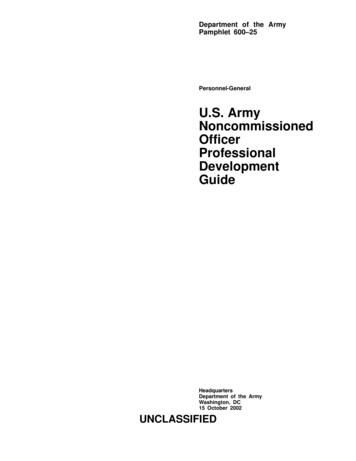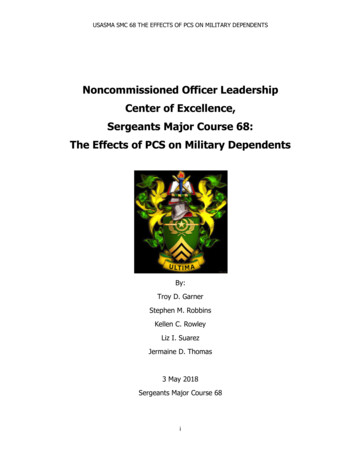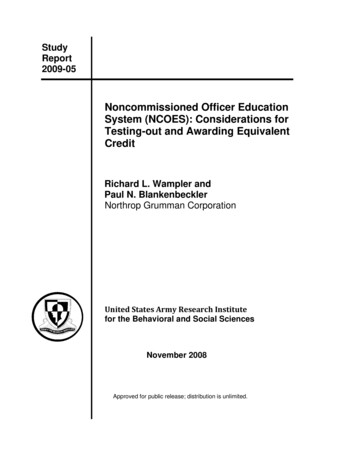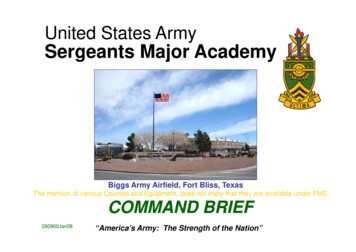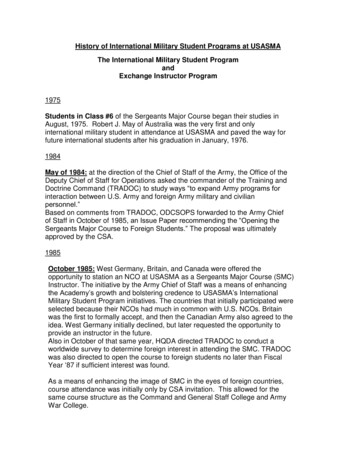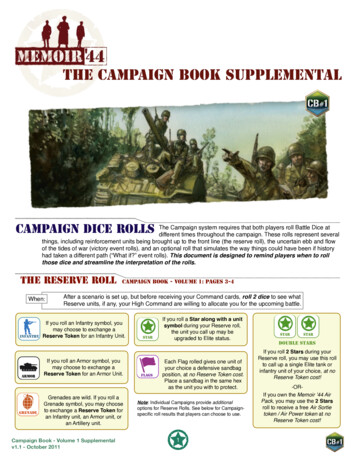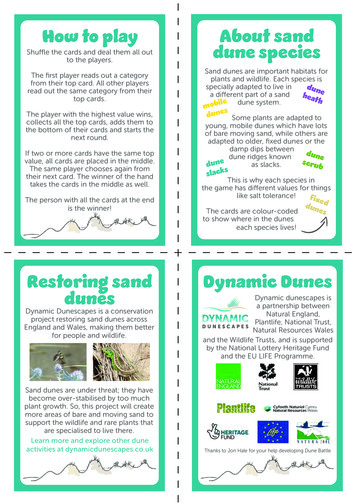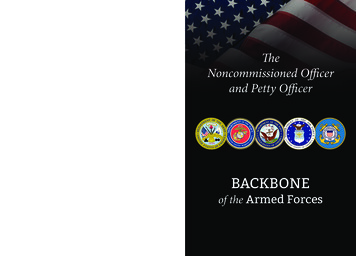
Transcription
U.S. ARMY SERGEANTS MAJOR ACADEMY(USASMA)BATTLE STAFF NONCOMMISSIONED OFFICER COURSE (BSNCOC)INDIVIDUAL STUDENT ASSESSMENT PLAN(ISAP)Instructions to the student: Effective date of this ISAP is 27 February 2017. Read this ISAP andcomplete the student acknowledgement on the last page. You will keep this ISAP for your records.This ISAP establishes student responsibilities and graduation criteria, details how noncommissioned officeracademies/regional training institutes (NCOAs/ RTIs) will determine if the student has demonstrated asufficient level of competency to pass, and informs the students of the testing strategy used to evaluate themon the training. This ISAP also informs students, facilitators, and other personnel of the course graduationrequirements. NCOAs/RTIs will explain this plan to the student at the beginning of the course, ensure thestudent has read and understood this ISAP, and post an unsigned blank copy in the BSNCOC area for thestudents’ reference.9-1. Student Responsibilitiesa. The technique of delivery for this course is Discussion, Small or Large Group (DSL). Thistechnique places the responsibility for learning on the student through participation in small or largegroups led by facilitators who serve as role models and facilitate throughout the course. A facilitator usessmall group processes, methods, and techniques to stimulate learning. The facilitator is one whofacilitates counseling, coaching, learning, and team building in DSL.b. The small group process is a technique for learning in small groups that capitalizes on (uses)student experiences, requires intensive student interaction, and makes each student responsible for his/herown learning. Cooperation takes precedence over competition. DSL provides individualized learning,team building, and maximum exchange of ideas.c. It is the responsibility of the student to learn to perform the training objectives of this course. Thisincludes adhering to the advance sheet, reading assignments, completing the homework assignments,completing the practical exercises (PEs), and fully participating in classroom/group room discussions andtraining activities. Student is encouraged to ask questions pertinent to the lesson prior to the exam.9-2. General Standardsa. Minimum Achievements. Student must complete all graded requirements, all homeworkassignments, all PEs, and all performance assessments. Student will attend all classes and trainingactivities. Failure to pass any of the course graduation requirements will constitute failure to meet coursestandards and the student will not graduate.b. Standards of Conduct. Student will conduct themselves in a manner expected of anoncommissioned officer. This includes demonstrating law-abiding personal conduct and behavior, bothon and off duty. The commandant may dismiss student from the course for any conduct or behavior thatviolates local, state, or federal law, including the Uniform Code of Military Justice (UCMJ) or for anyconduct or behavior that violates any Department of Defense (DOD), Army, or local regulation or policy.This includes, but is not limited to, substantiated cases of lying (oral or written, sworn or unsworn),
cheating, plagiarism, and improper relationships, e.g., senior-subordinate or student-cadre. Student shallbe at their appointed place of duty on time. Student may only miss a total of FOUR academic hours. If astudent misses more than four hours, he/she will be dismissed from the course. Any student whodemonstrates a pattern of lateness may receive dismissal consideration.c. Physical Readiness Training (PRT) Standards. There is no organized PRT during the BSNCOC.Students are highly encouraged to conduct PRT on their own in order to maintain physical readiness.d. Remedial/Refresher Training and Retesting. The facilitator will formally counsel students that failan initial assessment/evaluation. They shall provide remedial/refresher training and offer one retest. Theretest for the written assessments and/or Form 1009 assessments will be administered TWO duty daysafter the initial assessment. Commandants may grant a second retest to student who have matters ofextenuation for why they did not pass the first retest (i.e. Power failure during test, eyeglasses brokeduring test, medical emergency during test). A third test (second retest) can only be approved by thecommandant. Second retests will not be granted on the sole basis of the student’s desire to complete thecourse or on improvement of grades from the initial test to the retest. The senior facilitator is responsiblefor retests.e. Student Dismissal/Disenrollment. Commandant may remove a student from the course beforecompletion for disciplinary reasons, lack of motivation, and other valid reasons (such as illness, injury, oracademic deficiencies). A student’s failure to maintain standards during the course may constitute aninfraction of the UCMJ or may simply indicate a lack of motivation or aptitude. Students who violate theUCMJ may receive a suspension or dismissal from the course. Commandants may require them to reportto the court-martial convening authority. The facilitator will counsel a student whose actions demonstratea probable lack of motivation and may consider them for dismissal/disenrollment for motivational,disciplinary, or academic reasons.9-3. Course Graduation Requirements, Academic Grading, and Test Plana. There are TEN assessments used in this course: TWO exams and EIGHT Form 1009 Rubrics. Tomeet course graduation requirements students must achieve an overall rating of 70 percent or higher onSEVEN of the assessments (TWO exams and FIVE Form 1009 Rubrics) and meet height/weightstandards outlined in AR 600-9. Student evaluations will take place throughout the course. Uponcompletion of the BSNCOC, academies will issue students a copy of DA Form 1059 (Service SchoolAcademic Evaluation Report) indicating the student has successfully completed the BSNCOC.Out of the SEVEN assessments the following FOUR determine the GPA:(1) E101 Operations exam assessment – weight 15 percent of GPA. Consists of 25 multiplechoice questions. This is a performance-based assessment covering Mission Command, Staff Operations,Operational Environment, and Stability Operations. Time: 5 minutes instructions, 1 hour CLOSEDbook exam, and 1 hour review - (2:05).(2) E102 Plans, Orders, and Attachments (POA) exam assessment – weight 15 percent ofGPA. Consists of 25 multiple choice questions. This is a performance-based assessment covering POA.Time: 5 minutes instructions, 2 hour and 15 minutes OPEN book exam, and 1 hour review - (3:20).(3) Form 1009W Assessing Prepare an Overlay assessment – weight 35 percent of GPA. Thisis a performance-based assessment covering preparing an overlay within the Graphics and Overlayslesson plan. Student will be required to draw and label an operational overlay that consists of 50 events.Events are weighted at 2 points each. You will be authorized to use your Graphics Workbook on the
Test. Your Graphics Workbook will be checked by the facilitator and/or the assistant instructor (AI).This assessment is part of the lesson plan hours, not of the exam hours. Time: 15 minutes instructions, 3hour OPEN book assessment, and 2 hour review - (5:15).(4) Form 1009W Assessing COA Sketch and Narrative assessment – weight 35 percent ofGPA. This is a performance-based assessment that assesses the student’s ability to analyze a complextactical scenario from higher headquarters and demonstrate their understanding of Army operations anddoctrine. Student will be required to draw it on a map using current military symbology, and write anarrative of the sketch that consists of 22 events. You may use the Form 1009W COA Sketch andNarrative to assist you. You may also use the MDMP practical exercise that you completed as a group toassist you in developing this COA Sketch and Narrative. Ensure you understand which phase of theoperation the test instructions tell you to conduct in order to complete your COA and know where in therunning estimate that you need to retrieve information from for your COA Sketch and Narrative. Therunning estimate is provided to you in the test instructions. This assessment is part of the lesson planhours, not exam hours. Time: 15 minutes instructions, 3 hour OPEN book assessment, and 1 hour review- (4:15).Primary AssessmentsWeight Percentage1. E101 Operations Exam 15 percent2. E102 POA Exam 15 percent3. Form 1009W Assessing Prepare and Overlay 35 percent4. Form 1009W Assessing COA Sketch and Narrative 35 percentTOTAL 100 percentThe above percentage will be distributed and used according to this document. They shall calculate weightpercentage achievement to a percentage computed to the second decimal place (0.00 percent) to determinestudent’s completion of training.b. In addition, to meet course graduation requirements students must not FAIL more than one ofthe following THREE Form 1009 assessments:(1) Form 1009C Assessing Contribution to Group Work - The student must score a minimum of70 percent in order to receive a “satisfactory” rating.(2) Form 1009R Assessing Research Ability - The student must score a minimum of 70 percent inorder to receive a “satisfactory” rating.(3) Form 1009S Assessing Course of Action (COA) Decision Briefing - This is a performancebased assessment that assesses the student’s ability to give a COA Decision Brief during the B115MDMP LP. The student must score a minimum of 70 percent to receive a “satisfactory” rating.Note: If a student receives ONE “unsatisfactory” rating on either Form 1009, the student will receive a“Marginally Achieved Course Standards” on his/her DA Form 1059. If a student receives TWO“unsatisfactory” ratings on either Form 1009, the student will be dismissed from the course and receivea “Failed to Achieve Course Standards” on the DA Form 1059.c. The following THREE Form 1009s are practical exercises only, non-graded:(1) Form 1009S Assessing Country Briefing practical exercise(2) Form 1009S Assessing Mission Analysis Briefing practical exercise
(3) Form 1009S Assessing Battle Update Brief (BUB) practical exercise - This is a performancebased assessment that assesses the student’s ability to give a BUB during simulated operation in a TacticalOperations Center (during the Staff Exercise). The facilitator will assign one of the following sixwarfighting functions to the student, and the student must cover the required areas on the Form 1009S inorder to receive a “GO”:Mission CMD – Battle Captain (first to brief during the BUB): must cover 6 of the 8 areas.Intelligence – S2: must cover 5 of the 7 areas from enemy situation and 3 of the 4 areas from thecivil situation.Movement and Maneuver – S3: must cover 8 of the 11 areas.Fires – FIRES NCO: must cover all 3 areas.Protection – Protection NCO: must cover all 5 areas.Sustainment – S1: must cover all 3 areas.Sustainment – S4: must cover all 4 areas.Mission CMD - Battle Captain/S3: must cover 4 of the 6 areas.Mission CMD - Battle NCO/Operations NCO: must cover all 4 areas.d. Student may not get credit or take any tests prior to receiving the training. In the event a studentfails the primary exam but passes the retest, the student will only be given a 70 percent for thatassessment regardless of their score on the retest. Students who fail a retest, fail a reevaluation on anyForm 1009 assessment, fail to meet performance standards, fail to meet the general standards of the course,and/or require extraordinary assistance to remain in the course are subject to dismissal. The dismissalauthority for students in the BSNCOC is the Staff and Faculty Director at USASMA; local commandant atCamp Williams, UT; local commandant at Fort McCoy, WI; or local commandant at Fort Indiantown Gap,PA. A student wishing to appeal this dismissal must submit appeal through the BSNCOC director,USASMA, if attending at Fort Bliss or through the BSNCOC branch chief at the student’s location (CampWilliams, UT; Fort McCoy, WI; or Fort Indiantown Gap, PA) to the Commandant at the respectivelocation. Once the final decision is made, a memorandum will go through the chain of command to thestudent.e. NCOAs/RTIs Responsibilities(1) NCOAs/RTIs conducting the BSNCOC will use the aforementioned written assessmentsand performance assessments to ensure student can demonstrate overall mastery of course materialand meet course graduation requirements.(2) NCOAs/RTIs will evaluate academic grading and tests on a basis of the weight percentagelisted in 9-4a (1)-(4).(3) NCOAs/RTIs will provide remedial/refresher training to the student that fails an
assessment and offer them one retest (unless additional retests are approved by the commandant). Theretest will cover the entire test and not just the portion the student failed. Should a student fail theretest, the commandant will dismiss them from the course. Student may request second retest basedon matters of extenuation only. The desire to complete the course is not grounds for a second retest.(4) NCOAs/RTIs will award the student passing the retest the minimum passing score, which is70 percent, regardless of the student’s actual grade point achieved on the retest. NCOAs/RTIs willrecord the final retest score in student course records along with counseling and remediationdocumentation.Note: The following are NOT authorized during the test: cell phones, smart watches, tablets, cameras, orother unauthorized electronic devices. If a student is caught using any of the aforementioned electronicdevices, the student will be subject to dismissal.9-4. DA FORM 1059, Service School Academic Evaluation Report.Facilitators will evaluate each student’s academic performance on the DA Form 1059, Service SchoolAcademic Evaluation Report (AER) IAW DA Pam 623-3 for completion instructions. The AER willexplain the student’s accomplishments, potential, and limitations during the course. All entries will reflectthe actual performance of the student. The goal is to provide the student an original copy of the AER notlater than graduation day. NCOAs/RTIs will prepare the AER IAW with this ISAP. Facilitators shallconsider the following when making their evaluations:a. Item 11, Performance Summary. For the Performance Summary block, students may receive oneof four evaluations, based on the following:(1) EXCEEDED COURSE STANDARDS. Reserve “Exceeded Course Standards” rating to nomore than 20 percent of the class size. If more than 20 percent exceed course standards, student’s overallGPA will determine the outcome. There is no rounding up on GPAs. Student may achieve all“Superior” ratings on their DA Form 1059 and not exceed course standards. To achieve this evaluationstudent must:(a) Pass the FOUR primary assessments the first time with a score of 90 percent or higher.(b) Achieve a 90 percent or higher the first time on all graded Form 1009s: Assessing Preparean Overlay, Assessing Prepare a COA Sketch and Narrative, Assessing Contribution to Group Work,Assessing Research Ability, and Assessing COA Decision Briefing.(c) Receive “Superior” ratings in all FOUR evaluated demonstrated abilities blocks (item12) of the DA Form 1059: written communication, oral communication, contribution to group work,and evaluation of student’s research ability.(d) Participate fully in all BSNCOC activities.(e) Receive no adverse written counseling statements to include disciplinary and failing theinitial height/weight/body fat screening (must pass the initial height/weight/body screening the first time).(2) ACHIEVED COURSE STANDARDS. To achieve this evaluation student must:(a) Pass each Written Test Assessment with a 70 percent or higher.
(b) Pass each Form 1009 (Rubric) with a 70 percent or higher.(c) Receive at least four “Satisfactory” ratings or above in the demonstrated abilitiesblock (item 12) of the DA Form 1059.(d) Receive no more than one adverse written counseling statement.(e) Participate fully in all BSNCOC activities.(3) MARGINALLY ACHIEVED COURSE STANDARDS. Student will receive this rating ifthey:(a) Receive one “Unsatisfactory” rating in the demonstrated abilities block (item 12) ofthe DA Form 1059.(b) Receive two or more adverse written counseling statements.(c) Fail to participate fully in all BSNCOC activities.(d) Fail TWO or more of the four primary assessments and pass the retests.(e) Student who receives a “Marginally Achieved Course Standards” rating will receive areferred Academic Evaluation Report (DA Form 1059).(4) FAILED TO ACHIEVE COURSE STANDARDS. A student will fail to achieve coursestandards if any of the following apply:(a) Receives less than 70 percent on any written assessment, Form 1009Ws, and retest.(b) Receives two “Unsatisfactory” (UNSAT) ratings in the demonstrated abilities block (item12) of the DA Form 1059. See note on page 48.(c) Fails to meet the body composition standards (body fat) of AR 600-9 on the secondscreening.(d) Dismissed from the course for disciplinary reasons or violations of the standards ofconduct. See para 9-3b - Standards of Conduct.(e) Student who receives a “Failed to Achieved Course Standards” rating will receive areferred Academic Evaluation Report (DA Form 1059).b. Item 12, Demonstrated Abilities. For the Demonstrated Abilities block, student may receive oneof three evaluations in the three categories listed below, based on the following:(1) WRITTEN COMMUNICATION. NCOAs/RTIs will base each student’s writtencommunication rating primarily on the performance criteria outlined in the Form 1009W Assessing COASketch and Narrative.(a) Superior – To receive a “Superior” rating a student must score a 90 percent or higher onthe Form 1009W Assessing COA Sketch and Narrative.
(b) Satisfactory – To receive a “Satisfactory” rating a student must score a 70 percent to 89percent on each Form 1009W Assessing COA Sketch and Narrative.(c) Unsatisfactory – To receive an “Unsatisfactory” rating a student must score a 69percent or lower on the Form 1009W Assessing COA Sketch and Narrative. Student who fails toachieve a “Satisfactory” rating on the Form 1009W Assessing COA Sketch and Narrative (bothinitial and retest) will receive this rating.(2) ORAL COMMUNICATION. NCOAs/RTIs will base each student’s oralcommunication rating primarily on the performance criteria outlined in the Form 1009S AssessingCOA Decision Briefing.(a) Superior – To receive a “Superior” rating a student must score 90 percent or higher oneach Form 1009S Assessing COA Decision Briefing and not receive any written adverse counselingstatements for poor oral communication skills (e.g., excessive use of profanity, distinctiveness, orvoice control).(b) Satisfactory – To receive a “Satisfactory” rating a student must score a 70 percent to 89percent on each Form 1009S Assessing COA Decision Briefing and not receive any written adversecounseling statements for poor oral communication skills (e.g., excessive use of profanity,distinctiveness, or voice control). Note: Student who receives an “Unsatisfactory” rating on thebriefing, but receive a “Satisfactory” rating on the retest(s) may earn this rating.(c) Unsatisfactory – To receive an “Unsatisfactory” rating a student must score a 69percent or lower on each Form 1009S Assessing COA Decision Briefing or receive at least ONEadverse counseling statement for poor oral communication skills (e.g. excessive use of profanity,distinctiveness, or voice control). Student who fails to achieve a “Satisfactory” rating on the Form1009S Assessing COA Decision Briefing (both initial and retest) will receive this rating.(3) CONTRIBUTION TO GROUP WORK. NCOAs/RTIs will base each student’scontribution to group work rating primarily on performance outlined on the Form 1009C AssessingContribution to Group Work.(a) Superior – To receive a “Superior” rating a student must score a 90 percent or higher onForm 1009C Assessing Contribution to Group Work.(b) Satisfactory – To receive a “Satisfactory” rating a student must score a 70 percent to 89percent on Form 1009C Assessing Contribution to Group Work.(c) Unsatisfactory – To receive an “Unsatisfactory” rating a student must score a 69 percentor lower on Form 1009C Assessing Contribution to Group Work. A negative counseling statement forapathy, poor attitude, or failure to fully participate in training events will result in an automatic“Unsatisfactory” rating.(4) ASSESSING RESEARCH ABILITY. NCOAs/RTIs will base each student’s researchskills rating primarily on the performance criteria outlined in the Form 1009R Assessing Research.(a) Superior – To receive a “Superior” rating a student must score a 90 percent or higher onthe Form 1009R Assessing Research Ability.
(b) Satisfactory – To receive a “Satisfactory” rating a student must score a 70 percent to 89percent on the Form 1009R Assessing Research Ability.(c) Unsatisfactory – To receive an “Unsatisfactory” rating a student must score a 69 percentor lower on the Form 1009R Assessing Research Ability.9-5. Student Grievances and RedressStudents having a grievance will address that grievance to the facilitator or senior facilitator and then tothe course director or course manager. Student may also address their grievance to the commandant, ifnecessary. Students having a grievance involving discrimination or violation of policy should use thechain of command up to the commandant.9-6. Student Recognition and Award Programa. Students who successfully complete the BSNCOC will receive a DA Form 1059 Service SchoolAcademic Evaluation Report (AER) and a diploma.b. The students who earn the top two highest GPAs will receive recognition IAW USASMA,NCOA, or RTI policies. In the event of a tie, the average of the non GPA Form 1009C, Form 1009R,and Form 1009S will be the tie breaker. This recognition will be reflected in Block #14 of the DA1059.9-7. Point of Contact for ISAPa. SGM Michael H. Reed, director, BSNCOC, USASMA at DSN 621-9194, commercial (915) 7449194.b. MSG Shawn D. Ward, course manager, BSNCOC, Curriculum Development and EducationDivision (CDE), Directorate of Training (DOT), USASMA at DSN 621-1378, commercial: (915) 7441378.9-8. Student Acknowledgement and Understanding of this ISAPRankPrint Last NamePrint First NameSignature/date
includes adhering to the advance sheet, reading assignments, completing the homework assignments, completing the practical exercises (PEs), and fully participating in classroom/group room discussions and training activities. Student is encouraged to ask questions pertinent to the lesson prior to the exam. 9-2. General Standards a. Minimum .
